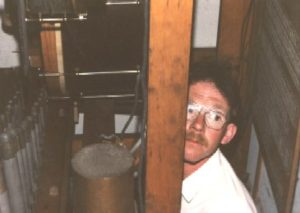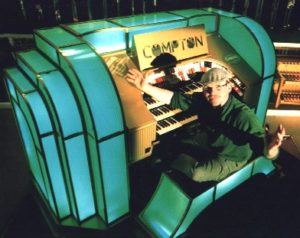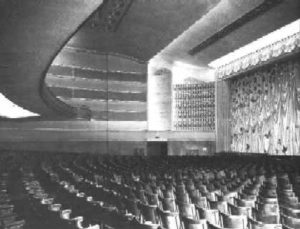Categories
History
The Pipes in the Peaks Compton has come a long way since it was originally built and installed in the cinema. Please use the links on the left to find out more…
History – More Recently
History of Pipes In The Peaks
Dave, at his re-installed console, in the Showroom.
How The Compton Was…
After removal from the ABC Derby, the organ was purchased, for a princely sum in 1965 of £300, by a Mr H Jackson of Castle Donnington. The instrument joined a considerable number of other privately owned Cinema Pipe installations in the same town at that time – including the WurliTzer from the Regent Sheffield, on which Reginald Dixon played before moving to the Tower Ballroom.
At the Jackson residence, the organ was crammed into a small chamber, which spoke out behind the organist, into a small room housing the console. Even at six ranks, excluding it’s Melotone unit, the maintenance and removal of many pipes and parts proved extremely difficult.

A view of the Polyphonic Tibia Bass and 16foot Tuba off-note chest. |

Caption Competition: “What have I let myself in for?” |
 |
 |
The Move to Dovedale…
Dave decided to purchase his Compton in 1990 from Mr Jackson, and after a 3 hour-long interview! With no experience of removing or rebuilding such an instrument, he knew that it was exactly what he’d wanted, ever since a little lad. Dave’s dream of owning a Cinema Organ began, when as a boy he was introduced to the delights of the WurliTzer at the Tower Ballroom, Blackpool.
After about 19 trips to and fro in a small van, the organ was carefully removed and put into storage at the garage. At this time, the Showroom had not been built, and over the next ten years, the complete restoration of every component part of the organ, and construction of the building took place. The Showroom is an addition to the existing Garage, and was specifically designed to house both cars, the Compton, and other “vintage” curios.
Every single item on the organ has been lovingly dismantled and rebuilt as new – chests, tremulants, regulators have all been re-leathered, the console fully rewired and re-painted in Gold and Black. The list goes on….

The Left Hand Side of the Surround after Painting |

The Console being rebuilt |
Various extra ranks have been added, to give a wider variety of sounds than was capable or required for the different application in the Cinema. Other effects have been added, such as Chimes and Vibraphone, due to the loss of the Melotone unit when the instrument was removed from the Regal/ABC.
 |
The console of the East Ham WurliTzer in the background, while re-leathering two Regulators |
Before the Compton was playing, Dave also purchased the East Ham 3c/8 WurliTzer, thinking that the Compton would not sound to his liking, but it did, and the WurliTzer went for re-installation into a Private Resisdence in Staffordshire.
| Adding the Finishing Touches to the Regulator |  |
The philosophy of both Dave and Stephen from the outset of the project, was to provide the audience with full view of every part of the organ – all without leaving their seats! All of the traps (or effects) and Piano are located around the stage. More recent additions, for instance the 18 tuned bird whistles and the automated drum-kit, and the extra pipe ranks have been specified and refurbished by Christian. The chamber is fitted with specially made glass panels, over 6mm thick, so that the pipes (and monkeys) can all be seen playing. If you’re interested, you can even see the blower…
The console now rests on a turntable lift, which formerly graced the Odeon Birmingam, although it now rotates through its 45-degrees of movement in the opposite direction. It is probably the only example in the UK still in operation.
Staging was re-used from the Regal Chesterfield, on which has stood the likes of Sir Cliff Richard, Winifred Atwell and the Beverley Sisters, to name but a few….
The Re-Opening…
On the evening of 3rd October 1999, The Old Lady first echoed in the valleys to a packed house, with Stephen at the keys. The organ had not been heard in public for over 35 years. The first sounds – “Thankyou for the Music” – Stephen’s signature tune, was completed with rapturous applause. At this time, all 9 ranks and effects were playing, but not without the customary “opening night hitch” – the organ was inadvertently silenced by the heating system!
Since that evening, further ranks have been added, and extra effects, such as the Piano Accordion.
Dave’s work is never complete – as any Cinema Organ owner will testify, his old Lady needs as much TLC to keep her in good tune and repair, for your enjoyment, as it took to install.
And the name “Pipes in the Peaks” – where does it come from? Have a day out in the beautiful heart of Dovedale, and find out!
History – Early Days
About the Regal/ABC Derby Compton Organ & Organists
The organ now at Pipes In The Peaks originally came from the Regal/ABC Derby in East Street. It was a standard design of Compton comprising of 3 manuals, 6 ranks of pipes, and a melotone attachment, serial number A432. It was billed on the cinema as ‘providing the most sensational and tonal effects ever heard in a cinema’. In 1965, the organ was put up for sale at £200 and was bought by Mr Harry Jackson of Castle Donnington. Sometime around this era, the non functional melotone unit was sent for repair, but was never returned. In 1990, it was bought by David Thorp, owner of Pipes In The Peaks.
The organ was opened on 27th June 1938 by Wilfred Southworth, who had come from the Forum Cinema, Birmingham. A few weeks after the opening, Wilfred drowned whilst on holiday. On the 11th of July, Hensow Maw aged 21 (from the Astoria Cinema Hull) took over his place and broadcast the organ on the 9th June and 12th July 1939. During the 1938/1939 period, Raymond Charles and other guest organists played at the Regal Derby for the occasional charity concert before legislation allowed cinemas to show films on Sundays. In 1945, 17 year old Peter Stevens was appointed as the resident organist.
Other organists who played at the Regal/ABC Derby Compton were:- Jack Scott from the Ritz Nuneaton, real name John Scott Williamson, Arthur Tipper, Clifford Birchall, Trevor Willets, George Blackmore, Arthur Lord, and Ken McKinley.
History – ABC/Regal Derby
The Regal opened on the 27th June 1938 with the film “Marie Walewska” with Greta Garbo and Charles Boyer. The last day of operation was the 14th July 1984 with a special screen of “Thats Entertainment” and a special nostalgic supporting programme. The official seating capacity of the cinema was 1,840









